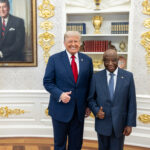“Adults in a Room” is a series in collaboration with The Stimson Center’s Reimagining US Grand Strategy program. The series stems from the group’s monthly networking events that call on analysts to gather virtually and hash out a salient topic. It aims to give you a peek into their Zoom room and a deep understanding of the issue at hand in less than the time it takes to sip your morning coffee without the jargon, acronyms, and stuffiness that often come with expertise.
Since the Iraq War and the War on Terror, there has been growing support for a restrained US foreign policy. Restraint is a big tent — composed of realists, conservatives, and progressives — which is a double-edged sword for influencing policy. Restrainers are largely united in calling for retrenchment from the Middle East and Europe. Yet, there is little agreement on how to approach China, which may challenge the restraint camp moving forward. January’s Reimagining US Grand Strategy roundtable brought members of the foreign policy community together to discuss the International Security article “Competing Visions of Restraint.”
The conversation began with remarks from two of the article’s authors on the underlying beliefs that have led realists, conservatives, and progressives to converge on restraint — and what variations exist within the restraint community. The group discussed and debated how these competing visions might evolve in a changing international landscape and the prospects for restraint under the Trump administration.
John Schuessler, Associate Professor, Department of International Affairs, and Co-director of the Albritton Center for Grand Strategy, Bush School of Government and Public Service, Texas A&M University
President Donald Trump is frequently described as an isolationist. I take issue with that characterization for two reasons. First, restraint, not isolationism, is the relevant position in the grand strategy debate. Second, restraint is animated by competing visions; there is not one version, but many. In short, it was always going to be an uphill battle for restraint to gain broad traction in a second Trump administration, even setting aside the president’s volatile mix of instincts. For all those hoping that Trump would provide an opening for restraint in the grand strategy debate, expectations should remain modest.
At the broadest level, one could be forgiven for believing that the grand strategy debate is between internationalists and isolationists, with the former embracing international engagement and the latter rejecting it. While it is doubtful that the internationalist/isolationist dichotomy ever applied, it certainly does not today. Rather, the true debate is between those who want the US to remain the dominant security provider in each of the core regions of East Asia, Europe, and the Middle East and those who argue that the US should be, at most, the security provider of last resort in one or more of those regions. The former position is best labeled deep engagement, and the latter position is best labeled restraint.
As my co-authors and I demonstrate, restraint is a big tent, which is a double-edged sword for its influence on the grand strategy debate. On the one hand, there are multiple ideological routes to restraint, drawing from realist, conservative, and progressive perspectives. Realists contend that deep engagement has backfired, leading to US overreach and prompting other states to counterbalance its power. Conservatives oppose deep engagement, believing it threatens the American way of life. Progressives argue that it perpetuates injustice and relies on military force for issues that require different approaches. Viewing the wars in Iraq and Afghanistan as a consequence of deep engagement, restrainers from all three camps found common ground in calling for a new approach, beginning with less military engagement in the Middle East.
For all those hoping that Trump would provide an opening for restraint in the grand strategy debate, expectations should remain modest.
On the other hand, precisely because restraint is a big tent, it is animated by competing visions, which makes it challenging for restrainers to unite on shared arguments and policies. This has been evident with the rise of China, Russia’s invasion of Ukraine, and Israel’s response to the Oct. 7 attacks, all of which have divided restrainers (and the foreign policy community more broadly). Realists and conservatives are especially wary of the rise of China, which could pose a threat to the balance of power as well as the American way of life if it becomes a hegemon. Progressives, in turn, are more inclined than realists and conservatives to support Ukraine to the hilt, as they see Russia as an especially pernicious threat to liberalism in Europe and beyond. Conservatives, finally, remain more firmly in the pro-Israel camp than realists and progressives, who see continued American embroilment in the Middle East’s wars as unwise or unjust or both.
Turning back to Trump, the president’s grand strategic instincts are mixed, to put it mildly. Like restrainers, he would like to see the wars in Ukraine and the Middle East end sooner rather than later. More broadly, he has been a long-standing skeptic of alliances like NATO that serve as vehicles for deep engagement. All that said, it would be going much too far to argue that Trump has any attachment to restraint as a position in the grand strategy debate. In his first term, Trump embraced competition with China, both in the economic and military spheres. He also ramped up the pressure on Iran, abandoning the carefully crafted agreement that had been in place to limit the latter’s nuclear program. “America First” might mean that Trump will put US interests ahead of those of others, but that does not mean he has been or will be consistently restrained.
In this context, it is probably disappointing to restrainers that Trump is appointing hawks like Marco Rubio to key positions. It should not be surprising, however. Restrainers themselves are more divided today than during the war on terror, and Trump simply does not share enough of their commitments to create a wide opening for the position in the grand strategy debate. For those who remain committed to restraint, the most viable path remains in the opposition.
Christopher Preble, Senior Fellow and Director, Reimagining US Grand Strategy Program, Stimson Center
I was pleased to have a chance to discuss the past, present, and future of the restraint movement, and especially gratified that such a large and diverse group of practitioners and thought leaders were able to participate. The article in the Fall 2024 issue of International Security, “Competing Visions of Restraint,” by Miranda Priebe, John Schuessler, Bryan Rooney, and Jasen Castillo, was the perfect vehicle for framing our discussion, and is sure to be a go-to source for others.
Within the Reimagining US Grand Strategy Program, we can see the very diversity that Priebe et al document. My colleagues and I deliberately organize our work around challenging the assumptions undergirding US foreign policy. We approach key questions from our own unique perspectives and backgrounds. And we sometimes disagree about the wisdom or folly of specific US policies, including about whether and how they advance US interests. In that respect, we reflect the range of views within the restraint coalition, from IR realists to norm-abiding liberals, and from libertarians and conservatives to progressives.
For my part, I believe that the critical element that unites our team — and ultimately the wider community — is a healthy skepticism of the efficacy of military power. Though the Pentagon’s budget approaches $1 trillion, and will almost surely surpass that in 2026, some GOP leaders on Capitol Hill believe that isn’t nearly enough. The Pentagon is so notorious for waste and mismanagement that it has never passed an audit, but some would solve that problem by throwing more money at it. Whether Elon Musk’s Department of Government Efficiency (DOGE) can or will counteract these impulses, and impose both greater budget discipline and badly needed reform, remains to be seen.
In the end, the need to divert ever-more resources to the military-industrial complex is likely to be primacy’s Achilles’ Heel. It writes checks that the body politic will not cash. The assertion that the American people will happily embrace cuts to Social Security and Medicare and endure higher taxes in order to funnel more money to the military is particularly risible. In that sense, I agree with Priebe et al that “the costs and risks associated with intensified great power competition could draw more supporters to the restraint position and produce a shift in US grand strategy in the future.”
That shift can’t happen on its own, however. Critics of US foreign policy, and the grand strategy of primacy on which it is founded, must alert people to the risks that primacy poses, including by drawing Americans into futile wars. And we all must work tirelessly to demonstrate the viable alternatives that can deliver safety and prosperity to the American people, but at much less cost.
William Ruger, President, American Institute for Economic Research
The last decade or so has seen the rise of both more scholarly discussion of grand strategy and greater attention by elites to the policy question of what type of grand strategy the US should follow going forward. Both occurred for a variety of reasons.
One is frustration and anger with what primacy had wrought in the post-Cold War era: bloody and costly “forever” wars that never realized the broad war aims of their architects, leaders trading off dealing with growing domestic challenges for foreign concerns, and the waning of unipolarity (due to changes in the nature of the international system outside of Washington’s direct control and its own corrosive miscues). Another key reason was the rise of Donald Trump and his America First challenge to the status quo, which contributed to the arguments for restraint, attracted attention to critics of the establishment more generally, and broke through some intellectual and partisan dams. Another important cause was greater philanthropic interest in promoting a broader national conversation on America’s role in the world — and building the infrastructure to do so.
Restraint gained popularity, among some on both the right and left, as an alternative to the reigning primacist consensus. Of course, this isn’t entirely new. One could argue that restraint is among America’s oldest strategic traditions given that today’s most important articulations of it have a lot in common with the approach espoused by Washington in his Farewell Address and John Quincy Adams in his July 4, 1821 speech. Moreover, American leaders practiced it reverently until at least 1898 (and adhered to the tradition of avoiding politico-military entanglements in Eurasia even longer).
Today’s restraint isn’t brand new or a product of GWOT failures. Various counter establishment figures in and out of academia articulated the core principles of restraint just after the Cold War. For example, Eric Nordlinger and Eugene Gholz, Daryl Press and Harvey Sapolsky at MIT made seminal intellectual contributions in academia. The Cato Institute continued its long-standing advocacy from the think-tank universe. And Pat Buchanan articulated a conservative version in the media and politics. But these efforts failed to have any serious impact in the immediate post-Cold War era as Washington settled quickly on a continuation, rather than a rethink, of primacy.
Restraint gained popularity, among some on both the right and left, as an alternative to the reigning primacist consensus.
Today, the restraint movement is much more robust than it was, which gives it a greater chance of having a significant impact than it did 30 years ago. There are many restraint-oriented individuals and institutions building, operationalizing, and communicating the case for this approach outside of government. Now we even see restrainers and restraint-adjacent individuals inside government.
But it is important to distinguish between restraint as a theory of grand strategy and restraint as a movement. The former contains specific ideas of how to use (and not use) the military to secure American national interests. These views are carefully grounded in assumptions and theories of international relations. They also hinge on a careful analysis of the nature of America and the international system today. Restraint theories focus on a relatively circumscribed set of conditions that would countenance the use of military power abroad, with most also wary of permanent alliances. Indeed, its purest form is thoroughly (George) Washingtonian.
Restraint as a movement, though, is a broader church and more about politics in action than political science. Therefore, it isn’t as concerned with theoretical commitments or even the stringent policy outcomes its theories would require. Instead, its main interest is policy change. Therefore, it operates as a counter-elite committed to changing US grand strategy away from the primacist status quo. For some, this means change on the margins while others wish to push for wholesale change. Thus there is a lot more looseness in the movement around issues like alliances, nuclear weapons, or how to best deal with the rise of China. Plus policy change often requires making arguments in a certain way in light of the political context at the given time — a challenge that big think strategists have to worry about less. A political movement, which requires a focus on the game of addition rather than subtraction, tends to embrace — even under its banner — those who are restraint-adjacent like off-shore balancers, prioritizers, and even responsible peace movement members, with whom theoretical restrainers might disagree. These elements came together in opposition to something, rather than a commitment to a shared vision. This was important, but paved over some real differences, some of which came out in the debates over how to deal with China and even more strikingly over the US approach to the war in Ukraine. It will be interesting to see how the movement evolves going forward and whether it can stick together to advance positive change, especially if foreign policy becomes an issue with a partisan divide.
Ransom Miller, Research Associate, Institute for Global Affairs
Since taking office, Trump has ushered in a number of high-level nominations from the world of restraint, particularly at the Department of Defense. That bodes well for Trump’s promises to reduce the global US military footprint. But Trump’s return is more likely to divide the restraint movement than unify it, even as he carries out some of its precepts.
Trump’s grand strategy is hard to pin down. Although his “America First” rhetoric is outwardly critical of the foreign policy establishment, Trump’s first term saw him act more in line with strategies of primacy. He frequently accosted US rivals across the world with everything from continuing air strikes in the Middle East to ratcheting up tensions with China. And his stated aims of peace are often at odds with his violent rhetoric toward foreign states and leaders, including US allies.
Then there’s Trump’s pledge to rebuild the military, even as he claims his legacy will be measured by “the wars we never get into.” Meanwhile, Elon Musk’s DOGE works to dismantle USAID, a major pillar of non-military engagement with the rest of the world.
For progressive restrainers, these contradictions are probably too much to bear. Figures like Bernie Sanders or Ro Khanna aren’t likely to get on board with Trump’s aggressive rhetoric, even to support elements of his foreign policy with which they might otherwise agree.
The restrainers with senior roles in the administration must compete with cabinet leaders with more traditional GOP perspectives. As Trump’s policy takes shape, he may de-prioritize restraint. He may decide he has to make good on some of his threats against foreign powers, for example by invading Panama. Or, he may want to stick it to the Washington establishment and further elevate his restraint-minded advisers. It’s difficult to predict.
Trump’s second term is unlikely to commit to any one cohesive grand strategy, including restraint. There will be no universal answer as to whether restrainers should work to support Trump’s foreign policy or denounce it. In order for a big-tent movement like this to maintain its momentum, restrainers will have to keep talking to one another — even as they strongly disagree about the president’s actions.
Elizabeth Shackelford, Senior Policy Director, Dickey Center for International Understanding at Dartmouth College
Some voters and politicians were drawn to Donald Trump’s claims that he would rein in America’s misguided foreign interventions and redirect its global engagements to putting “America First.” Sadly, those who believed that are probably the only ones who can’t see the egg on their face today. Instead, the US has an aggressive and expansive foreign policy that angers its allies and delights its adversaries, as Washington accumulates its own goals at an astonishing speed. It’s hard to keep track of all the ways Trump is undermining US interests, so I’ll focus on three.
First, Trump has deliberately targeted Washington’s closest allies with coercive tactics to secure “concessions” that had already happened. Mexico sending 10,000 troops to the border? That happened in 2021 absent any threats, based on simple diplomatic engagement; Mexico already has 15,000 troops stationed there now. Canada’s $1.3 billion border plan? That was announced in December. Trump is claiming victories he didn’t win, and the threats have done little but destroy the goodwill and trust these allies once had in us. And after the 25% tariff threat, are Canadian businesses and consumers going to lean in on trade and partnership with US businesses? I think not.
Second, Trump is eviscerating the US’s capacity to use non-military tools to achieve its national security interests. Anyone who hoped Trump would rein in military intervention should understand that an effective foreign policy utilizes non-military tools to minimize the need to default to hard power. This is why China is currently engaged in a trillion-dollar worldwide investment and infrastructure project called the Belt and Road Initiative. This effort is successfully building closer economic and diplomatic ties with countries across the globe. Meanwhile, Trump’s billionaire buddy Elon Musk has fed the country’s foreign assistance capacity “into the wood chipper.” If the US wanted to compete effectively with China for influence in the world, it would be tripling its foreign aid instead of gutting it.
Finally, Trump has refused to rule out using military force to enforce his expansionist territorial threats. He claims that he’ll take over the Panama Canal, buy Greenland, and make Canada the 51st state, not to mention his plan to take over Gaza. I’d discourage anyone from making light of these claims. Even if it’s just bluster, the damage is done. Words matter in relationships, and international relationships matter to US security. Trump has just ruined several of them.




















